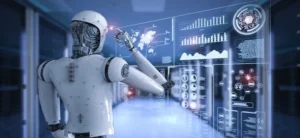Artificial Intelligence (AI) has made remarkable advancements in recent years, revolutionizing various industries and aspects of our daily lives. However, along with its promise come legitimate concerns about the potential risks and dangers associated with AI technology. Here are the top 10 scary facts about artificial intelligence that you need to know:

1. AI Bias and Discrimination
- Research: Studies have shown that AI systems can perpetuate and even exacerbate biases present in their training data, leading to discriminatory outcomes.
- Example: In hiring processes, AI algorithms have been found to favor certain demographics over others, reinforcing societal biases and perpetuating inequality.
2. Job Displacement
- Research: With the rise of automation and AI-powered technologies, there is a growing concern about the loss of jobs across various sectors.
- Example: Industries such as manufacturing, transportation, and customer service are already experiencing significant job displacement as AI becomes more capable of performing tasks traditionally done by humans.
3. Privacy Invasion
- Research: AI algorithms can analyze vast amounts of data to infer personal information and behaviors, raising concerns about privacy invasion.
- Example: Social media platforms and online retailers use AI to track user behavior and preferences, potentially compromising individuals’ privacy and autonomy.

4. Deepfake Manipulation
- Research: Deepfake technology, powered by AI, can create highly realistic fake videos and audio recordings, enabling malicious actors to manipulate public opinion and spread misinformation.
- Example: Deepfake videos have been used to create convincing footage of politicians saying or doing things they never did, posing a serious threat to democracy and trust in media.
5. Autonomous Weapons
- Research: The development of AI-powered autonomous weapons systems raises ethical concerns about the possibility of uncontrollable warfare.
- Example: Autonomous drones equipped with AI could make decisions without human intervention, leading to unintended harm and escalating conflicts beyond human control.

6. Cybersecurity Threats
- Research: AI can be used by cybercriminals to launch sophisticated cyberattacks, posing a significant threat to individuals, organizations, and critical infrastructure.
- Example: AI-powered malware can adapt and evolve to bypass traditional cybersecurity defenses, making it challenging to detect and mitigate cyber threats effectively.
7. Loss of Human Control
- Research: As AI systems become more autonomous and intelligent, there is a risk of humans losing control over these technologies, leading to unpredictable outcomes.
- Example: Self-driving cars equipped with AI may encounter situations where human intervention is necessary but may lack the ability to make nuanced decisions, potentially resulting in accidents or fatalities.
8. Amplification of Disinformation
- Research: AI algorithms used by social media platforms can inadvertently amplify disinformation and extremist content, leading to polarization and societal unrest.
- Example: Recommendation algorithms that prioritize engagement metrics may inadvertently promote divisive and sensationalist content, exacerbating social divisions and undermining democratic discourse.

9. Existential Risks
- Research: Some experts warn about the potential existential risks posed by advanced AI systems surpassing human intelligence and capabilities.
- Example: The hypothetical scenario of a superintelligent AI with goals conflicting with human values could pose an existential threat to humanity if not properly controlled or aligned with human interests.
10. Lack of Accountability and Transparency
- Research: The complexity of AI algorithms and decision-making processes can make it difficult to hold responsible parties accountable for AI-related errors or misconduct.
- Example: When AI systems make biased or discriminatory decisions, it may be challenging to identify the root cause and allocate responsibility, hindering efforts to address and rectify the issue.
In conclusion, while artificial intelligence offers tremendous potential for innovation and progress, it is crucial to be aware of the potential risks and dangers associated with its development and implementation. By understanding these scary facts about AI, we can work towards mitigating risks and ensuring that AI technologies are developed and used responsibly for the benefit of society.

Frequently Asked Questions
Q. What is artificial intelligence (AI)?
Answer: Artificial intelligence (AI) refers to the simulation of human intelligence in machines that are programmed to mimic human-like tasks such as learning, problem-solving, and decision-making.
Q. What are the benefits of AI?
Answer: AI has numerous benefits, including automation of repetitive tasks, improved efficiency and productivity, enhanced decision-making through data analysis, advancements in healthcare diagnostics and treatment, and innovation in various industries such as transportation and finance.
Q. What are the risks associated with AI?
Answer: Some of the risks associated with AI include job displacement due to automation, biases and discrimination in AI algorithms, threats to privacy and cybersecurity, the proliferation of deepfake technology for misinformation, and concerns about the loss of human control over autonomous AI systems.
Q. How can biases affect AI algorithms?
Answer: Biases in AI algorithms can arise from biased training data or the design of the algorithms themselves, leading to discriminatory outcomes such as favoring certain demographics in hiring processes or perpetuating stereotypes in decision-making.
Q. What are some examples of AI applications in everyday life?
Answer: AI applications are prevalent in various aspects of everyday life, including virtual assistants like Siri and Alexa, recommendation systems on streaming platforms and e-commerce websites, predictive analytics in healthcare, autonomous vehicles, and facial recognition technology used for security and authentication purposes.

